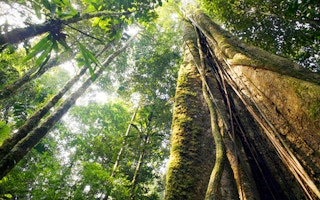Most residents of tropical rain forests know the easiest way to make money: cut down the surrounding trees. Through timber, crops or cattle, the people who live in the forests can eke out an income to pay for health care or education for their children. But, more than anyone else, these people know the damage this does. They know it takes generations for a forest to come back after it’s cut down. They know that destroying the forest will destroy their way of life. And they’re looking for an alternative.
In past decades there have been many top-down approaches to saving forests, implemented by multinationals, national governments and international nonprofit organizations. These often did not consider the communities in and around them. One approach was to buy the forests and put a virtual fence around them; another was to set restrictions on what can be done in the forest. The “buy-and-fence” strategy was aimed at the activities of outsiders looking for timber or minerals. The “set restrictions” strategy prevents forest communities from slashing and burning their trees to plant cash crops or run cattle. The United Nations’ Reducing Emissions from Deforestation and forest Degradation, or REDD, and REDD+ programs are more recent versions of these top-down strategies based on creating a financial value for the carbon stored in forests, as are private-sector carbon offset schemes that make trees worth more alive than dead.
“
There is another way, though: Help the people who live in the “lungs of the planet” to make a living that allows them to protect their forests
None of these strategies has been fully effective. Buy-and-fence is expensive, putting environment-minded governments and non-governmental organizations in a bidding war against global corporations with some of the deepest pockets on the planet. Restrictions are hard to enforce in an area with low population densities, minimum or no enforcement funding or infrastructure, heavy tree cover, and no roads — plus they condemn the people who live in the forest to lives of global irrelevance. And programs such as REDD are rife with bureaucratic complications.
There is another way, though: Help the people who live in the “lungs of the planet” to make a living that allows them to protect their forests. Such a bottom-up approach works with local communities to map their needs, desires, culture, knowledge and skills — and then matches these to the income-generating opportunities unique to each individual rainforest (such as eco-tourism, production of indigenous handicrafts, or harvest of nuts or other foods) to create a sustainable, workable alternative to slash-and-burn or extractive options. This approach encourages participation from local governments, local nonprofits and businesses, particularly in identifying business opportunities and bringing them to fruition.
This is the approach we’ve taken since 2007 at Rainforest Partnership, an Austin, Texas–based nonprofit where I am the executive director. From brooms made from sustainably sourced palm fibers, to artisan products, to an ecolodge for bird-watchers eager to catch a glimpse of the elusive Andean cock-of-the-rock, we’ve helped communities create sustainable livelihoods while saving their forests and their way of life. While only one part of the multifaceted equation needed to save rain forests (which includes large-scale approaches such as reducing consumption in developed countries), this approach — empowering local communities to protect their own land — has proven to be an effective approach.
Take, for example, the women of Sani Isla, Ecuador. When we first met them in 2009, they were too shy to even speak with us or meet our eyes. At the start of our first workshop with them in the summer of 2010, they still hardly spoke. Later that first day, though, when they finally started talking, they told us why: Nobody had ever asked them what they thought or what their vision was. But they did indeed have a vision: for their forest and their way of life to be protected. To achieve their vision, they wanted to recover the dying art of making artisanal products such as jewelry, bags and baskets from seeds, vines and fibers from the surrounding forest. Rainforest Partnership helped them set up relationships with nearby ecolodges in their Amazon community and with hotels in Quito to sell their goods. The older women began training the younger ones, and we helped them create a plan for sustainably harvesting the raw materials they would need, which they used to create goods of startling beauty that sold beyond anyone’s expectations.
In four years, these women have gone from never having made a dollar to making a steady and growing income. And today the same women who were too shy to talk to us have become the strongest voices in their communities against the oil drilling that threatens to destroy their forest. Now they are at the forefront of protecting their forests — and their future.
Some question the scalability of this strategy; others say its results don’t come quickly enough. But as more forest communities search for a way to make a living while keeping their forests standing, the approach can be replicated. Successes our organization and others have had working directly with these communities show that this bottom-up approach is a critical piece in efforts to protect rainforests.
We don’t need to have untold amounts of money to buy the Amazon basin or to enforce rules to save tropical rain forests. By working with forest communities to help them bring their skills, traditions and values to the marketplace, we can overcome the most powerful driving forces of deforestation. Communities are asking for alternatives to destroying their forests for income. We need to help them find ways to earn the money they need while protecting their forests and their way of life.
Niyanta Spelman is the founder and executive director of Rainforest Partnership. This post originally appeared in Ensia.










